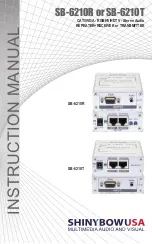
PS71090
E
Product Manual
October 2019, Rev A
WESTELL.COM
©2019 Westell
Technologies
September 2019;
Doc No. CS14702802UM
rD
1.877.844.4274
Page 31 of 61
Install a wall anchor in each of the four (4) drilled holes.
3.
Install the top two (2) screws into the anchors, leaving enough room to slide the
screws into the oblong holes of the top of the unit’s mounting positions.
4.
Once the Unit is hung on the top two (2) screws finish fastening the top screws.
5.
Install the bottom two (2) screws into the anchors, fastening the Unit to the
wall.
5.5 Verifying the Physical System Setup
•
Check all cables for shorts and opens. Verify that there are no cables with loose or poor
connections. RF leakage could cause oscillation to occur under some conditions.
•
If the rooftop antenna (donor antenna) is directional, check it for proper alignment along the
calculated compass heading. Typically, the directional antenna would be aimed at the same
site that your handset uses, but that may not always be the case.
•
If cables and alignment are acceptable, and a problem persists, use a spectrum analyzer to
examine the signal environment in which the unit is operating. The existence of strong
adjacent channel signals within the frequency band(s) can cause the AGC to reduce the
amplifier’s gain or cause alarms. In some cases, additional filtering or attenuation may be
required to reject these unwanted signals. In some instances, the donor antenna can be
reoriented horizontally to place the interference source in an antenna pattern null.
5.6 Controlling the Signal Booster
Control and monitoring the Signal Booster requires that a properly configured computer with Westell
PS71090E control software installed is connected via an Ethernet cable, such as the one shown in
Figure 5-2A. Connect the Ethernet cable from the Network Interface port of a computer to the GUI
port on the bottom end panel of the Signal Booster.
















































